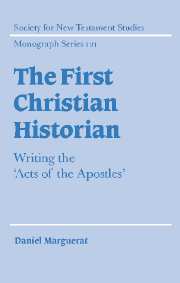Book contents
- Frontmatter
- Contents
- Preface
- 1 How Luke wrote history
- 2 A narrative of beginnings
- 3 The unity of Luke–Acts: the task of reading
- 4 A Christianity between Jerusalem and Rome
- 5 The God of Acts
- 6 The work of the Spirit
- 7 Jews and Christians in conflict
- 8 Ananias and Sapphira (Acts 5. 1–11): the original sin
- 9 Saul's conversion (Acts 9; 22; 26)
- 10 The enigma of the end of Acts (28. 16–31)
- 11 Travels and travellers
- Bibliography
- Index of passages
9 - Saul's conversion (Acts 9; 22; 26)
Published online by Cambridge University Press: 22 September 2009
- Frontmatter
- Contents
- Preface
- 1 How Luke wrote history
- 2 A narrative of beginnings
- 3 The unity of Luke–Acts: the task of reading
- 4 A Christianity between Jerusalem and Rome
- 5 The God of Acts
- 6 The work of the Spirit
- 7 Jews and Christians in conflict
- 8 Ananias and Sapphira (Acts 5. 1–11): the original sin
- 9 Saul's conversion (Acts 9; 22; 26)
- 10 The enigma of the end of Acts (28. 16–31)
- 11 Travels and travellers
- Bibliography
- Index of passages
Summary
‘The historian's sole task is to tell the facts just as they have occurred.’ This injunction is from the famous second-century rhetor, Lucian of Samosata, whom I have cited more than once for his valuable theorizing of ancient historiography. In this case, this very simple prescription aims to guarantee the objectivity of the historian in the face of the risks of pressures or flattery toward the addressees, but it reflects well enough the requirement of accuracy which was made of Graeco-Roman historiography.
How would Lucian have reacted to reading the three accounts of Saul's conversion as presented by the book of Acts? Each time there is the ‘same’ episode of Saul blinded on the Damascus road, falling to the ground, then receiving the revelation of God's surprising choice of him. However, between the first narration of the event in chapter 9, and the two autobiographical repetitions in speeches by Paul (Acts 22. 1–21 and 26. 1–23), the variations are considerable. This combination of repetition and variation is a testing ground for the exegesis of the book of Acts. When a scholar responds to the question why there are three accounts of Saul's conversion, one is able to identify the methodological orientation that governs his/her work. The biopsy is infallible. I shall immediately warn the reader that this book will not break the rule.
My intention is to re-examine this classical question by adopting a narratological point of view.
- Type
- Chapter
- Information
- The First Christian HistorianWriting the 'Acts of the Apostles', pp. 179 - 204Publisher: Cambridge University PressPrint publication year: 2002



